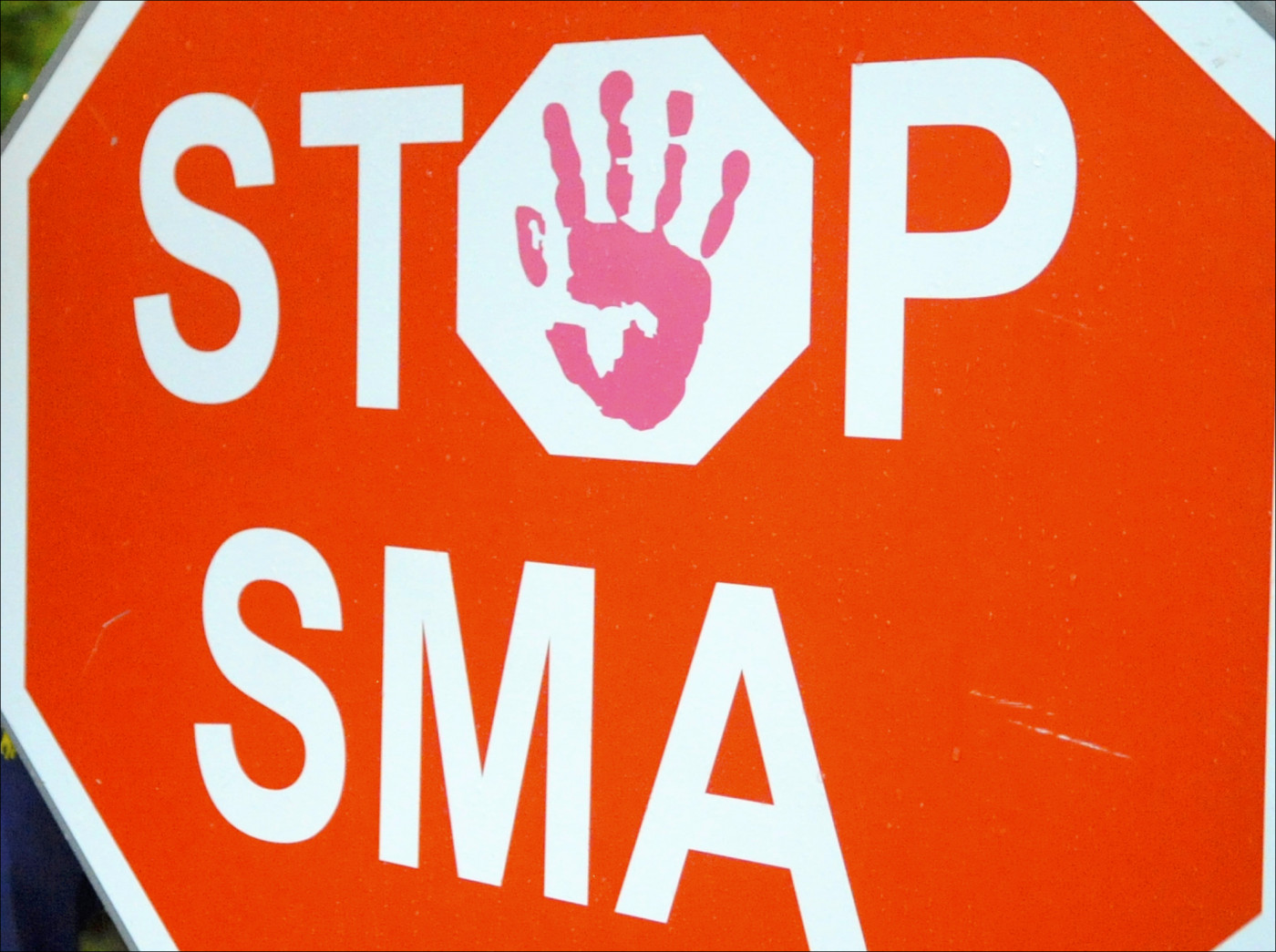ICER: Spinraza, Zolgensma Both ‘Dramatically Improve’ Lives of Kids With SMA
Written by |

Banner at a spinal muscular atrophy conference in Warsaw, Poland. (Photo by Larry Luxner)
Spinraza (nusinersen), an injectable medication approved two years ago by the U.S. Food and Drug Administration (FDA) to treat spinal muscular atrophy (SMA), is way overpriced. But so is its biggest potential competitor — Novartis‘ gene therapy Zolgensma — even though both have substantially helped children receiving either treatment.
That is the conclusion of the Boston-based Institute for Clinical and Economic Review (ICER), an independent, nonpartisan watchdog agency that objectively evaluates the clinical and economic value of prescription drugs.
In a long-awaited evidence report issued Feb. 22 ahead of a public meeting of the New England Comparative Effectiveness Public Advisory Council set for March 7 in Boston, ICER recommended that Spinraza should cost anywhere from $72,000 to $130,000 for the first year of treatment, and $36,000 to $65,000 in subsequent years. That’s 83 percent less than the drug’s current retail price of $750,000 the first year and $375,000 each year after.
The agency made its determinations using a common industry measure that values each “quality-adjusted life year” (QALY) gained at $100,000 to $150,000, though for rare diseases like SMA, thresholds of $500,000 per QALY are not uncommon.
“Both of these treatments appear to dramatically improve the lives of children with SMA, as well as the families who take care of them,” David Rind, MD, the chief medical officer at ICER, said in a press release. “And while Spinraza has a broader body of evidence that provides more certainty around the health benefits patients may receive, the limited data on Zolgensma suggest that the gene therapy has the potential to deliver large benefits through a one-time treatment.”
Ask questions and share your knowledge of SMA in our forums.
Rind added: “Unfortunately, at its current pricing, Spinraza far surpasses common thresholds for cost-effectiveness. Among the various companies that are now bringing gene therapies to market, Novartis has a real opportunity here to demonstrate both scientific and ethical leadership by setting the launch price of Zolgensma in line with the benefits patients will likely receive.”
That means charging between $310,000 and $900,000 using standard methodology, but as high as $1.5 million using alternative measures of health gain. Either way, it’s still a lot less than the $4 million to $5 million proposed by AveXis, which first developed Zolgensma as AVXS-101 before being acquired by Novartis last year for $8.7 billion.
FDA likely to approve Zolgensma by May
ICER’s preliminary draft evidence report, issued on Dec. 20, 2018, found that Zolgensma could be more cost-effective than Spinraza with a one-time price of $2 million. That prompted a Biogen spokeswoman to tell Reuters the report was “an incomplete representation of Spinraza’s value to patients and healthcare systems” since the drug had been given to nearly 6,000 patients, compared to a group of only 15 patients receiving Zolgensma in a pivotal Phase 1 clinical trial.
Zolgensma is a one-time gene therapy that is intended to restore production of a working and full-length SMN protein in specialized cells that control muscle contraction, called motor neurons. It contains a functional copy of the SMN1 gene, which is defective in most SMA patients, leading to markedly lower levels of a working SMN protein and subsequent loss of motor neurons, progressive muscle weakness, and atrophy.
Spinraza is intended to boost the ability of the SMN2 gene to also generate full-length and functional SMN protein. Without Spinraza, most of the protein produced from SMN2 is unstable and shorter than usual.
The FDA could approve Zolgensma as early as May; the drug’s one-time cost could outweigh the long-term expenses of caring for people with SMA over a 10-year period.
Despite its high cost, Spinraza, which launched in early 2017, has generated worldwide revenues of $1.72 billion for Biogen.
In ICER’s 197-page final report, the agency noted that currently available trials of Spinraza for all types of SMA and Zolgensma for SMA type 1 show prolonged survival and improved motor function compared with historical controls or placebo injections.
“However, there remain several important uncertainties,” the report said.
“First, for both interventions, the narrow eligibility criteria of trials and the limited sample size (especially for Zolgensma) raises concerns about generalizability of results to the wider population of patients with SMA. The ineligible or otherwise unselected patients are likely more severely ill, experience different or additional comorbidities, or have a different genetic profile than those selected for the clinical trials.”
In addition, ICER noted a lack of data on the long-term safety and effectiveness of both Spinraza and Zolgensma.
“Because SMA is a rare disease and the trials have short-term follow-up, understanding the long-term effects of Spinraza or Zolgensma will take time,” it said. “For Spinraza, there is uncertainty in the long-term effects of the repeated lumbar punctures in patients, particularly as they age or progress along the disease course.”
And for Zolgensma, it’s not known how long the gene therapy can provide lifelong benefit to SMA patients.
“If the expression wanes over time, the subsequent treatment pathway is unclear,” the report said, warning that if antibodies to AAV [adeno-associated virus] form, “the patient would be unable to receive another dose of Zolgensma.”







